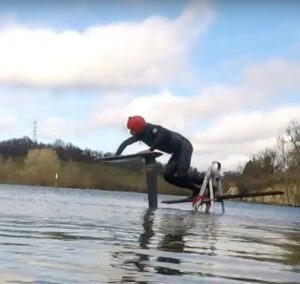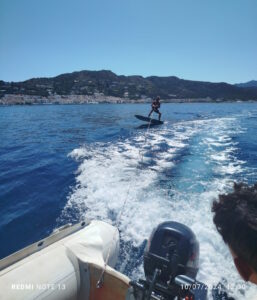You will see videos of people jumping from anywhere; a rock, a jetty without a run-up, from the beach… but they are very experienced people so for now forget about that and look for a good dock where you can get a comfortable run-up.
The ideal are usually floating jetties so you can put the foil under without worrying about hitting it. The ideal height would be about 30 centimeters. If it is lower you can do it but your jump to the board will be greater and you will lose precision. If it is higher you will have to go too crouched and it will be very annoying to run like that with the board.
To find it you can use Google Maps to explore your area, you can also search for rowing or canoeing clubs in your area because many times they usually have a jetty of these characteristics nearby. Docks for boats tend to be too high.
There are different options:
- Sea ports. Although it depends on the place there is a good chance that they will prohibit you
- Lakes and swamps. Check the regulations of the place to avoid problems.
- River dams. Be careful because the dam can be high but at the bottom there are often stones or logs, so you would have to swim around the area before launching with the foil.
- Estuaries. This is usually a typical place for rowing, with calm and deep waters, ideal for setting up jetties.
Ideally, you should have at least 10 metres to run, so you will have plenty of time to accelerate slowly (without skidding due to quick starts), place your hands in the right place, and apply pressure to the foil so that it starts working. The minimum distance would be 3 metres to be able to take at least 2 steps, but you will have to be very explosive to get the necessary speed in such a small space, as in the example in the following video.
At the end of the dock (the place where you have to get on the board) it should be clear and deep on both sides. Keep in mind that the board can make an unexpected turn at any time, and you may be able to throw yourself into the water before reaching the limit, but the board with the foil can continue advancing a few meters easily.

There should also be deep water, at least 2 meters. You might think that if you cover 1 meter you can keep the foil from hitting the bottom, but with your weight on top and a low-liter board you can easily send the foil with the board 2 meters below.
Depth is not just a matter of not damaging the equipment, if you are surfing and hit the bottom for example you can hurt your knee from the sharp impact. Also if your board turns, your foil has a span of almost a meter and the bottom is one meter, then one side of the foil will touch the ground and you could fall on the other and hurt yourself a lot (even nail it) when the foil hits a stop on the other side.



